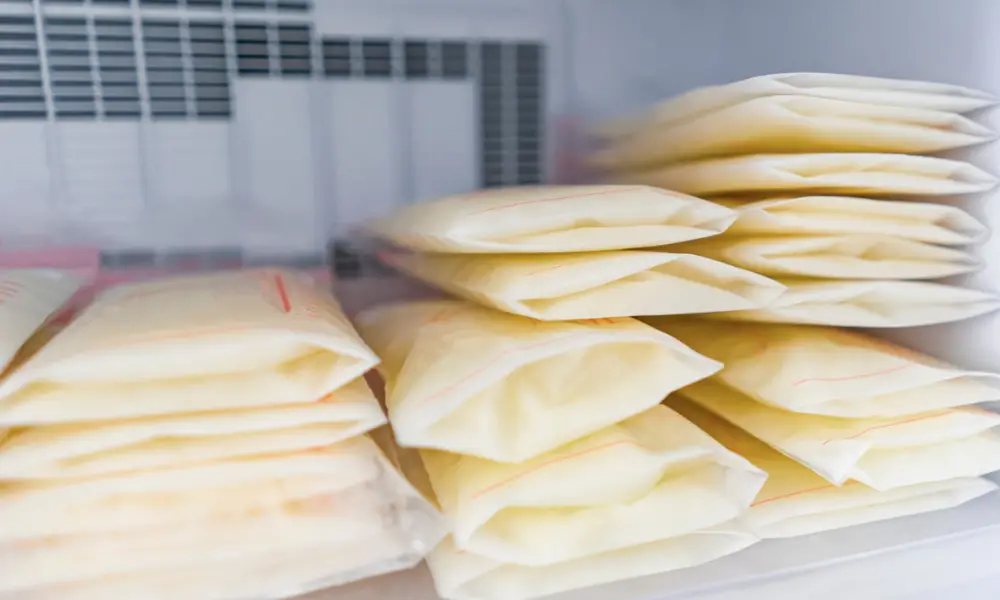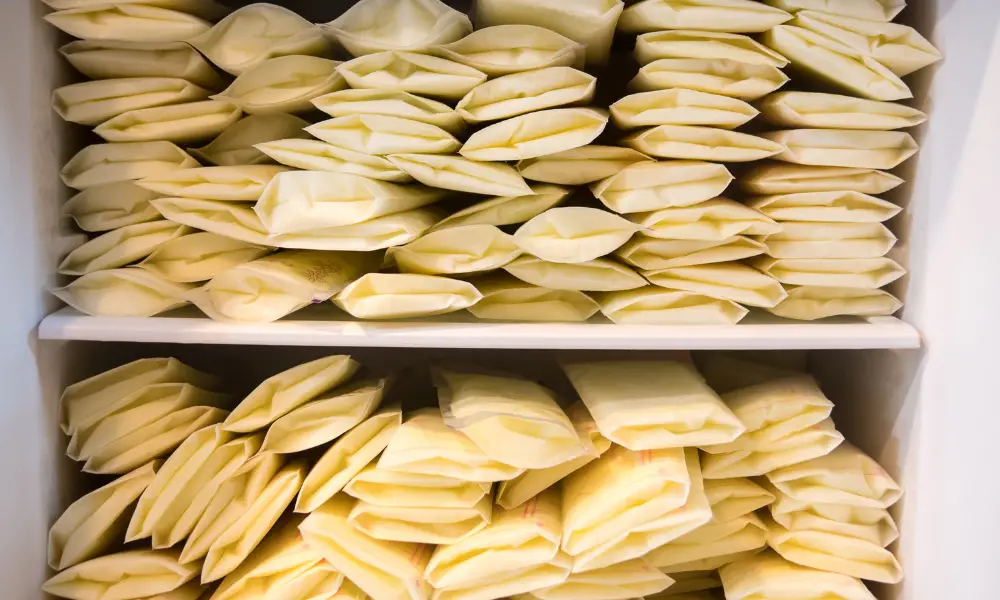How to freeze breast milk flat might be on your mind if you plan to save it. Especially if you’re producing an excess, storing breastmilk can be difficult. You may conserve a significant amount of freezer space by freezing your milk. Up to four days can pass if it is kept chilled.
According to the CDC, however, frozen breastmilk can be kept for up to a year. Although using the freezer to its fullest potential is a fantastic technique to address the issue of breast milk storage, there is still a space issue.

How to Freeze Breast Milk Flat?
Being a new mom and navigating the breastfeeding world can be difficult. Here is a step-by-step tutorial on flatly frozen breastmilk bags to simplify the process.
- Wash and Pump
When it comes to pumping and storage, washing your hands excessively is not a thing. A compromised milk supply is less likely to occur in a more hygienic operation.
It is essential to start with clean pump components and clean hands.
- Label the Baggies
Use the permanent marker to mark the date and time of the session while you are pumping. Avoid touching the storage bag’s opening and interior as well.
The majority of storage bags feature a place for this. Masking tape as a backup label is a good idea because this can rub off.
Nothing is more frustrating than being forced to throw away a bag of milk you worked so hard to get simply because you can’t read the label. Keep the time and date close to the top to make it simple to see afterward.
- Transfer Milk
Sanitize first, once again. Use hand sanitizer to clean the baggie’s exterior to ensure it is extra clean.
Again, avoid anything that will come into contact with the milk while it is being stored. During the freezing procedure, external contaminants will degrade the quality of the breastmilk.
Each bag should have less milk in it. At first, this may seem laborious, but as your baby’s needs increase, it will prevent waste.
In the beginning, four to five ounces per bag is a fantastic choice. More thawing can always be done, but it cannot be refrozen once the milk has thawed.
Therefore, if something is frozen too much or unused, it must be thrown out.
- Seal and Keep
Carefully hold the baggie upright and assist in squeezing out any extra air before sealing it. Next, close the bag.
To ensure that the seal is very tight, it doesn’t harm to check several times. When it comes to breastmilk, spilled milk is something to be upset about.
Locate a space in the freezer’s back to flat freeze your milk. If you keep it away from the door, it will be shielded from any temperature changes when the freezer is opened.
A flat surface, such as a plastic container or baking sheet, can aid in milk freezing as uniformly as possible for the initial freeze. Additionally, it will become the ideal size and form for long-term storage.
Is it Acceptable for Frozen Breast Milk to have Air Bubbles?
When thawing breastmilk for use or storing it in the freezer, air bubbles may be one thing you notice. Although it’s a very typical occurrence for women, it can be fully avoided and must be avoided at all costs. Yet why?
Breast milk that has been frozen with air bubbles may develop freezer burn. You generally won’t get freezer burn if the milk is kept in the freezer for a brief period, perhaps a few weeks.
However, you risk freezer burn if the frozen milk is kept for a longer period, such as up to six months (per CDC recommendations).
Aside from that, you want to prevent milk bubbles once the bag has defrosted. As a result, the infant can take in too much air when eating.
Their delicate digestive system may become caught with the extra air, resulting in extreme gassiness, fussiness, and pain.
In extreme instances, babies may develop severe colic, making their tummy pain much worse and nearly inconsolable.
It’s crucial to take the right actions to reduce the air trapped in your breastmilk storage containers.
How to Store Breast Milk?
In the Refrigerator
For safe refrigerator storage of expressed milk, abide by the following rules:
After expressing, put your breast milk in the refrigerator as soon as possible.
Use BPA-free storage containers or clean breast milk bottles to keep your milk fresh. Due to its hazy long-term consequences, several industries are moving away from the chemical BPA, which was once widely utilized in plastic containers and coatings.
You can add small amounts of expressed milk to the same refrigerator container if the milk has already cooled there. Don’t mix milk that has already chilled with body-temperature milk.
Breast milk should be kept in the back of the refrigerator, on the shelf above the vegetable section, where it is the coldest. Keep it out of the refrigerator door where the temperature is less consistent.
In the Freezer
To properly freeze breast milk, continue reading:
After expressing, freeze your breast milk as soon as you can.
Breast milk that has already been frozen can be supplemented with expressed milk as long as the milk has first been chilled in the refrigerator. Frozen milk shouldn’t be mixed with body-temperature milk.
Store your milk in tiny quantities to facilitate simple defrosting and reduce waste (less than 60 ml). Following defrosting, these can be blended.
Verify that the containers you choose to store your breast milk can be used in the freezer. Some goods, including glass bottles, may fracture at extremely low temperatures. Because they are freezer-proof, prepared for use, and simple to label, Medela breast milk storage bags are excellent for keeping frozen breast milk.
Is it Better to Store Breast Milk in a Bag or Bottle?
Both storing techniques have advantages and disadvantages. If you intend to keep breast milk in the refrigerator for one or two days, it is better to store it in bottles. This makes it simple to give the baby that milk rapidly. If you intend to freeze breast milk for longer-term storage, it is recommended to put it in bags.
If you are a parent, you are aware that not all parents must approach situations similarly.
Finding the strategies that help you and your child get through each day is the essence of parenting. Breastmilk storage is no different.
Both bags and bottles will do the trick. Depending on your priorities and preferences, one solution may be preferable.
How to Monitor the Amount of Breast Milk in your Freezer?
Many folks enjoy keeping tabs on how much breast milk they have. Here are a few simple ways to keep tabs on your freezer supply.
An App for Pumping
You can keep track of how much breast milk you have frozen at any given time with pumping apps like Milk Maid or Pump Log. The benefit of this method is that it handles all the arithmetic for you, and you can easily update your total whenever milk is added or removed.
The majority of total stash calculator apps do cost a few dollars.
Spreadsheet
Another excellent method for keeping track of breast milk bags is a spreadsheet, which gives you complete control over the recording process.
Whiteboard
Every time you add or remove milk, you may update the total amount of ounces (or breast milk bags, depending on how you like to track) on a magnetic whiteboard attached to the outside of your freezer.
Use Outside Writing
Write the total amount of oz/ml on the outside of each zip-top bag, box, or storage container after you’ve filled it up so you can quickly calculate the volume when you open the freezer.
How to Tell that Frozen Breast Milk has Gone Bad?
Specks of White in Frozen Breast Milk
Breast milk splits into a fat (cream) and a liquid when it is frozen. Your frozen milk may include white specks that are the fat component. You might have noticed that the top of the container is where the fat separates. For instance, the front face of the bag will have white spots if you keep your breast milk in freezer bags that were previously frozen and laid flat.
When this occurs, gently stir the milk once it has thawed to combine the components.
The Fragrance of Frozen Breast Milk
Breast milk naturally contains lipase. Its function is to break down milk components to make them easier for your kid to digest and absorb while also assisting in the battle against disease-causing microorganisms. Some females overproduce lipase, which speeds up the breakdown of milk fat. This occasionally alters the flavor or aroma of breast milk. Some claim that the milk tastes sour or has a soapy smell. Most newborns do not perceive changes to the milk after it has thawed, even though we might.
Try scalding your milk after pumping if your baby rejects the thawed milk. This causes lipase to function in the other direction and can stop the development of many tastes or odors.
What will Happen if your Baby Consumes Spoiled Breast Milk?
Inadvertently giving your infant rotten breast milk will result in them rejecting it or dribbling breast milk from the corner of their mouth. They might also be moving about and shoving nipples out of their mouths.
These facial expressions are a typical human reaction to food that tastes bad, even if they are not always a sign that a baby has been given tainted breast milk. Breast milk that has been bad tastes sour.
Therefore, before looking into other causes for why your baby is not drinking from the bottle, examine the quality of the breast milk or formula if your infant is exhibiting worry while drinking from a bottle.
A Newborn can Become Ill
Most likely, if your infant drank tainted breast milk, they would throw it up. They will be OK after they vomit it out. But if they keep throwing up, you might want to consult your child’s doctor.
You can stop worrying after babies vomit rotten milk out of their bellies.
Please continue to monitor them for any additional symptoms, such as persistent vomiting or diarrhea and potential dehydration. So, consult your pediatrician if you notice that they are frequently vomiting.
However, most newborns will be alright if they consume tainted breast milk. Therefore you should avoid giving it to your child.
Breast milk typically doesn’t spoil if you handle and store it according to recommended procedures.
Reference: Theophylline Secretion Into Breast Milk
Only on days when the mother was taking theophylline did the infant of an asthmatic patient exhibit the irritation linked to breast milk consumption. Theophylline spreads well in breast milk, according to pharmacokinetic tests done on this woman and four other participants. The drug’s typical milk-to-serum concentration ratio was around 0.7, and the time course of milk concentrations was synchronized with serum and saliva concentrations. A nursing newborn typically receives less than 10% of the mother’s theophylline dose, which is typically negligible based on relative body weight.
Conclusion
Putting breast milk in the freezer may seem like a good idea, but you need to store the milk correctly if you want to avoid freezer burn. You can do this by using storage bags designed specifically for this purpose. The best bags will be flat and take up less space in the freezer.
You can also purchase plastic containers specifically for storing frozen breast milk. These are great because they can be used in the fridge and can be labeled to keep track of the amount you’re storing.
